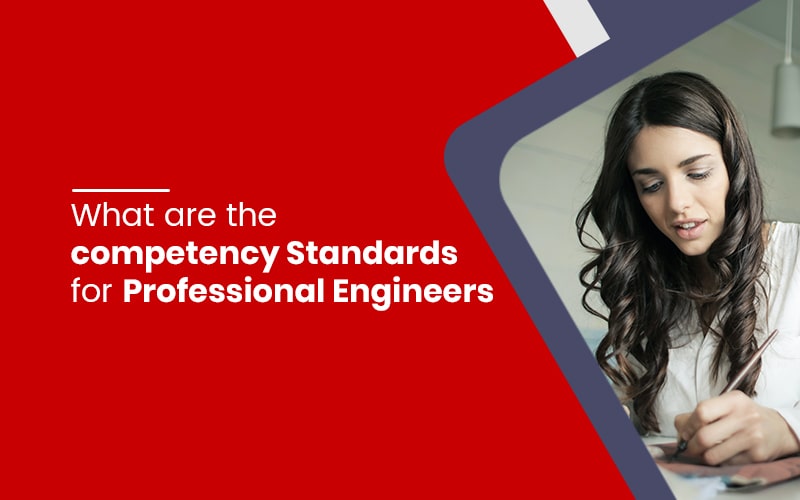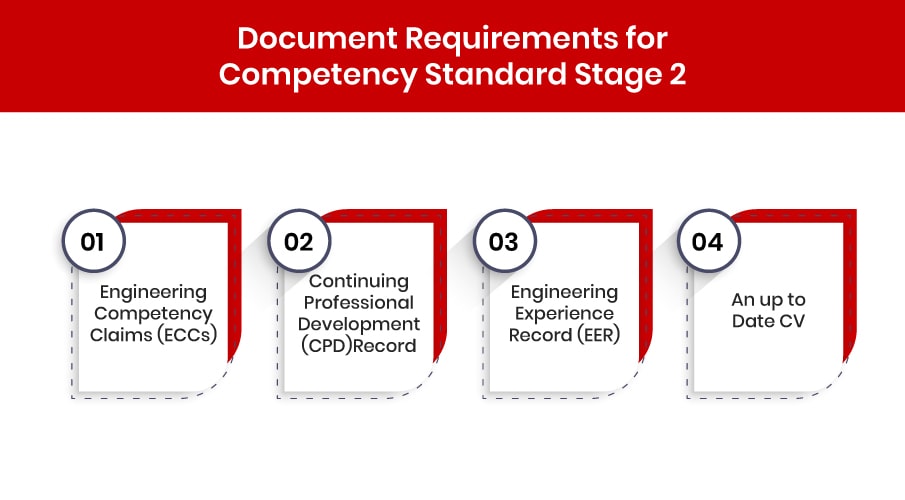What is the Competency Standard Stage 2 for Professional Engineers?

Table of Contents
Competency Standard Stage 2 is a criterion for an applicant to achieve Chartered Professional Engineer status. The Stage 2 Competency Standard reflects the applicant’s knowledge, skill, engineering application abilities, technical qualifications, principles, and disciplines that an applicant must display to work individually or unaccompanied.
As the name suggests, chartered professionals have attained the highest level of professional competencies through many years of hard work, skills, and experience. So to get recognized as a Chartered Professional Engineer by Engineers Australia, your skills are tested in various areas of expertise.
Purpose of Competency Standard Stage 2
As part of Stage 2, competency standards are based on a commitment to service, demonstrating value at work, technical proficiency, and having an obligation to the community. The competency standard stage 2 assessment is the first step toward becoming a Chartered Member of Engineers Australia (CPEng) and joining the National Engineering Register (NER). These professions are recognized by the government and by people all over the world. You will be required to maintain competency in your area of expertise.
As a professional Engineer, you will be expected to deliver various competencies according to your experience. Let us discuss the important parts of the competencies.
- Learn the requirements of the consumers, stakeholders, and society.
- Aiming to expand the growth of economic, social, and environmental aspects over a lifetime of engineering products.
- Cope with other professionals from diverse backgrounds
- Indicate that the engineering input is fully incorporated into the overall project or program.
- Interpreting technical possibilities for culture, industry, and government
- Ensuring that prices, risks, and limits are fully understood about the outcomes
- Ensuring that technological and non-technical aspects are adequately balanced
- Managing risk and maintaining long-term viability
- Ensuring that all facets of a project, method, or procedure are built on sound logic and basic values
- Simply identifying how emerging technologies apply to old ones
Professional engineers’ work ignores the interactions between humans and technology. They make significant contributions to engineering science and improve engineering practice. The Stage 2 Competency Standards apply to all engineering practices, divided into four basic units.
- Personal Commitment
- Obligation to the community
- Value in the workplace
- Technical proficiency
Pathways for Competency Standard
Applicants can apply for Stage 2 Competency through the following pathways: these are the pathways to prepare a genuine report that reflects the knowledge they have gained.
- Professional Development Program (PDP)
- Engineering Competency Report (ECR)
- Mature Experience Engineer (MEE)
- Mutual Recognition Agreement (MRA)
Document requirements for Competency Standard Stage 2

Applicants must go through a series of document submissions to acquire Chartered recognition. These documents will be required to qualify for a Professional Engineer.
- Engineering Competency Claims (ECCs)
- Continuing Professional Development (CPD) Record
- Engineering Experience Record (EER)
- An up-to-date CV
Engineering Competency Claims (ECCs)
Engineering Competency Claims (ECC) requires you to mention your core competencies and work experience. Your involvement in the technological field of engineering is reflected through Engineering Competency Claims. The total number of competency claim to be submitted depends on the type of pathway you choose. For example, you need sixteen engineering competency claims for the ECR pathways.
Continuing Professional Development (CPD) Record
Continuing Professional Development (CPD) shows your skills and knowledge in the engineering field you claimed. It is an important part of the National Engineering Registration (NER) application. You must show how many CPD hours you’ve accomplished in the past three years. It includes the details on your commitment towards the engineering product, technological efficiency, and standards you reflect in the workplace.
Engineering Experience Record (EER)
This document includes all your work experience records. You have to mention the employer’s name under which you’ve worked, and you also must mention the job roles and responsibilities performed during your employment period. The word limit for Engineering Experience Record (ERR) is about 700 words.
Up-to-date CV
You must upload the latest Curriculum Vitae/ Resume for your Stage 2 assessment application. Include your recent work experience history and the one you are currently involved in. It must be simple and written in a precise manner.
Demonstration of competence for a Professional Engineer
The provision of written reports of work, including engineering contributions – based on the bodies of knowledge associated with established engineering practice and engineering science – is required to prove competence. Many elements of engineering practice may be based on well-established but unpublished principles or procedures that are not frequently recorded or written but are taught via practice under the guidance and supervision of a more experienced engineer.
Provide examples of contributions to work that meet some or all of the following characteristics of either an engineering problem or an engineering activity when selecting work experience to show as proof of competence:
Engineering problems
- Include a wide range of potentially contradictory technological, social, environmental, and other criteria
- Have no clear answer and need abstract thinking and inventiveness in analysis to develop appropriate models.
- Necessitate the use of basic principles
- Involve difficulties that are rarely faced.
- Include a wide range of potentially contradictory technological, social, environmental, and other criteria
- Have no clear answer and need abstract thinking and inventiveness in analysis to develop appropriate models.
- Necessitate the use of basic principles
- Involve difficulties that are rarely faced.
Learn More: How to apply for ACS Skill Assessment. 💪💪
Engineering activities
- Involve the coordination of different resources (including people, money, equipment, materials, information, and technology) in the timely delivery of results.
- Need the resolution of important issues emerging from interactions between diverse or conflicting technical, social, environmental, or other constraints
- Involve the creative application of engineering principles and knowledge, much of which is at or informed by the forefront of a practice area;
- Have significant consequences in a variety of contexts, characterized by the difficulty of prediction and mitigation; and
- Can go beyond previous experiences by applying first principles.
- Require effective outcomes to be delivered on time and within budget.
A professional engineer applying for Stage 2 assessment would anticipate certain areas growing with others at a functional or proficient level at any one moment, as detailed below.
- Developing: a new area of your practice, with assistance from more experienced practitioners and maybe supervision, enables your practice to be acceptable.
- Functional: a component of practice in which you have the fundamental capacity to practice independently at an appropriate level without assistance or supervision.
- Proficient: an element of practice in which your ability to practice independently has been recognized via formal peer evaluation, and you can assist others in developing their skill.
A successful Stage 2 exam will formalize the transition from functional to competent.
Read More: Top jobs in Australia for Skilled Migration. 🛩️🛩️
CDRWritersAustralia for your assistance.
You can rely on us to prepare your Competency Standard Stage 2 assessment documents. We have experts on our teams with experience in preparing such a report. Whether it is about preparing your Engineering Competency Claims, Engineering Experience Record, Continuing Professional Development, or even a resume, we guide you through the whole process, so your assessment can go on without any hindrance.
Recent Posts
- Benefits of RPL Writing for Professional Advancement—Seize the Opportunity! July 8, 2024
- Unlocking Your Potential: Benefits of NER Registration for Engineers—Don’t miss out! July 4, 2024
- 8 Advantages of being a Registered NER Engineer April 25, 2024
- Stage 1 Competency Standard for Professional Engineer December 4, 2023
- Secure Your Future: The Most In Demand Jobs for Skilled Migrants to Australia in 2024 November 3, 2023






